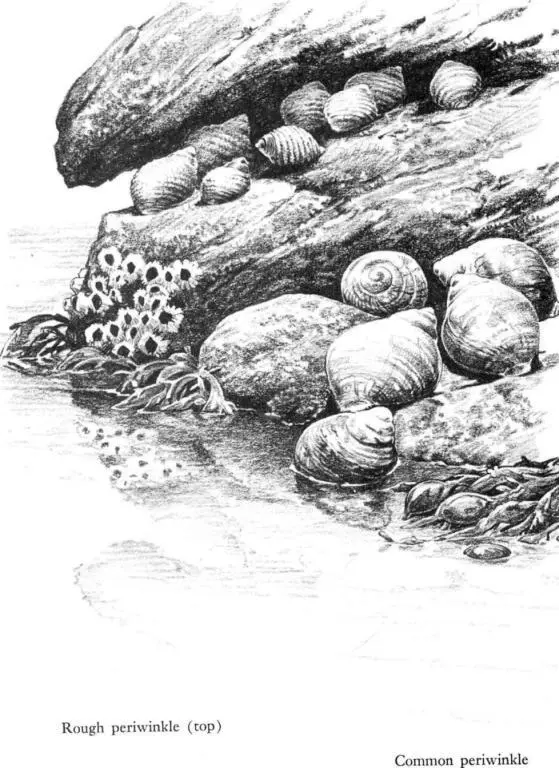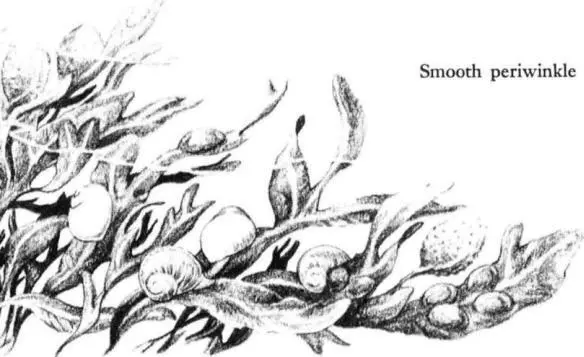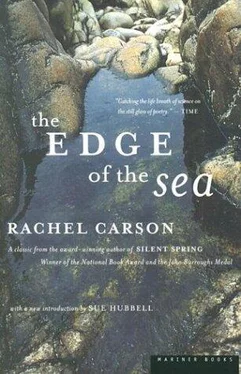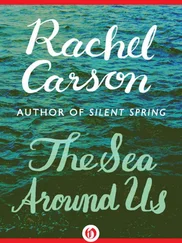Rachel Carson - The Edge of the Sea
Здесь есть возможность читать онлайн «Rachel Carson - The Edge of the Sea» весь текст электронной книги совершенно бесплатно (целиком полную версию без сокращений). В некоторых случаях можно слушать аудио, скачать через торрент в формате fb2 и присутствует краткое содержание. Город: Boston, Год выпуска: 1998, ISBN: 1998, Издательство: Mariner Books, Жанр: Биология, sci_ecology, sci_popular, на английском языке. Описание произведения, (предисловие) а так же отзывы посетителей доступны на портале библиотеки ЛибКат.
- Название:The Edge of the Sea
- Автор:
- Издательство:Mariner Books
- Жанр:
- Год:1998
- Город:Boston
- ISBN:978-0-395-07505-0
- Рейтинг книги:4 / 5. Голосов: 1
-
Избранное:Добавить в избранное
- Отзывы:
-
Ваша оценка:
- 80
- 1
- 2
- 3
- 4
- 5
The Edge of the Sea: краткое содержание, описание и аннотация
Предлагаем к чтению аннотацию, описание, краткое содержание или предисловие (зависит от того, что написал сам автор книги «The Edge of the Sea»). Если вы не нашли необходимую информацию о книге — напишите в комментариях, мы постараемся отыскать её.
A book to be read for pleasure as well as a practical identification guide,
introduces a world of teeming life where the sea meets the land. A new generation of readers is discovering why Rachel Carson’s books have become cornerstones of the environmental and conservation movements. New introduction by Sue Hubbell.
The Edge of the Sea — читать онлайн бесплатно полную книгу (весь текст) целиком
Ниже представлен текст книги, разбитый по страницам. Система сохранения места последней прочитанной страницы, позволяет с удобством читать онлайн бесплатно книгу «The Edge of the Sea», без необходимости каждый раз заново искать на чём Вы остановились. Поставьте закладку, и сможете в любой момент перейти на страницу, на которой закончили чтение.
Интервал:
Закладка:
The pattern of life spread before me when I emerge from that forest path is one characteristic of exposed shores. From the edge of the spruce forests down to the dark groves of the kelps, the life of the land grades into the life of the sea, perhaps with less abruptness than one would expect, for by various little interlacing ties the ancient unity of the two is made clear.
Lichens live in the forest above the sea, in the silent intensity of their toil crumbling away the rocks as lichens have done for millions of years. Some leave the forest and advance over the bare rock toward the tide line; a few go even farther, enduring a periodic submersion by the sea so that they may work their strange magic on the rocks of the intertidal zone. In the dampness of foggy mornings the rock tripe on the seaward slopes is like sheets of thin, pliable green leather, but by midday under a drying sun it has become blackened and brittle; then the rocks look as though they were sloughing off a thin outer layer. Thriving in the salt spray, the wall lichen spreads its orange stain on the cliffs and even on the landward side of boulders that are visited by the highest tides of each moon. Scales of other lichens, sage-green, rolled and twisted into strange shapes, rise from the lower rocks; from their under surfaces black, hairy processes work down among the minute particles of rock substance, giving off an acid secretion to dissolve the rock. As the hairs absorb moisture and swell, fine grains of the rock are dislodged and so the work of creating soil from the rock is advanced.
Below the forest’s edge the rock is white or gray or buff, according to its mineral nature. It is dry and belongs to the land; except for a few insects or other land creatures using it as pathways to the sea it is barren. But just above the area that clearly belongs to the sea, it shows a strange discoloration, being strongly marked with streaks or patches or continuous bands of black. Nothing about this black zone suggests life; one would call it a dark stain, or at most a felty roughening of the rock surface. Yet it is actually a dense growth of minute plants. The species that compose it sometimes include a very small lichen, sometimes one or more of the green algae, but most numerously the simplest and most ancient of all plants, the blue-green algae. Some are enclosed in slimy sheaths that protect them from drying and fit them to endure long exposure to sun and air. All are so minute as to be invisible as individual plants. Their gelatinous sheaths and the fact that the whole area receives the spray of breaking waves make this entrance to the sea world slippery as the smoothest ice.
This black zone of the shore has a meaning above and beyond its drab and lifeless aspect—a meaning obscure, elusive, and infinitely tantalizing. Wherever rocks meet the sea, the microplants have written their dark inscription, a message only partially legible although it seems in some way to be concerned with the universality of tides and oceans. Though other elements of the intertidal world come and go, this darkening stain is omnipresent. The rockweeds, the barnacles, the snails, and the mussels appear and disappear in the intertidal zone according to the changing nature of their world, but the black inscriptions of the microplants are always there. Seeing them here on this Maine coast, I remember how they also blackened the coral rim of Key Largo, and streaked the smooth platform of coquina at St. Augustine, and left their tracings on the concrete jetties at Beaufort. It is the same all over the world—from South Africa to Norway and from the Aleutians to Australia. This is the sign of the meeting of land and sea.
Once below the dark film, I begin to look for the first of the sea creatures pressing up to the threshold of the land. In seams and crevices in the high rocks I find them—the smallest of the periwinkle tribe, the rock or rough periwinkle. Some—the infant snails—are so small that I need my hand lens to see them clearly, and among the hundreds that crowd into these cracks and depressions I can find a gradation of sizes up to the half-inch adults. If these were sea creatures of ordinary habits, I would think the small snails were young produced by some distant colony and drifted here as larvae after spending a period at sea. But the rough periwinkle sends no young into the sea; instead it is a viviparous species and the eggs, each encased within a cocoon, are held within the mother while they develop. The contents of the cocoon nourish the young snail until finally it breaks through the egg capsule and then emerges from the mother’s body, a completely shelled little creature about the size of a grain of finely ground coffee. So small an animal might easily be washed out to sea; hence, no doubt, the habit of hiding in crevices and in empty barnacle shells, where often I have found them in numbers.

At the level where most of the rough periwinkles live, however, the sea comes only every fortnight on the spring tides, and in the long intervals the flying spray of breaking waves is their only contact with the water. While the rocks are thoroughly wet with spray the periwinkles can spend much time out on the rocks feeding, often working well up into the black zone. The microplants that create the slippery film on the rocks are their food; like all snails of their group, the periwinkles are vegetarians. They feed by scraping the rocks with a peculiar organ set with many rows of sharp, calcareous teeth. This organ, the radula, is a continuous belt or ribbon that lies on the floor of the pharynx. If unwound, it would be many times the length of the animal, but it is tightly coiled like a watch spring. The radula itself consists of chitin, the substance of insects’ wings and lobsters’ shells. The teeth that stud it are arranged in several hundred rows (in another species, the common periwinkle, the teeth total about 3500). A certain amount of wear is involved in scraping the rocks, and when the teeth in current use are worn down, an endless supply of new ones can be rolled up from behind.

And there is wear, also, on the rocks. Over the decades and the centuries, a large population of periwinkles scraping the rocks for food has a pronounced erosive effect, cutting away rock surfaces, grain by grain, deepening the tide pools. In a tide pool observed for sixteen years by a California biologist, periwinkles lowered the floor about three-eighths of an inch. Rain, frost, and floods—the earth’s major forces of erosion-operate on approximately such a scale.
The periwinkles grazing on the intertidal rocks, waiting for the return of the tide, are poised also in time, waiting for the moment when they can complete their present phase of evolution and move forward onto the land. All snails that are now terrestrial came of marine ancestry, their forebears having at some time made the transitional crossing of the shore. The periwinkles now are in mid-passage. In the structure and habits of the three species found on the New England coast, one can see clearly the evolutionary stages by which a marine creature is transformed into a land dweller. The smooth periwinkle, still bound to the sea, can endure only brief exposure. At low tide it remains in wet seaweeds. The common periwinkle often lives where it is submerged only briefly at high tide. It still sheds eggs into the sea and so is not ready for land life. The rough periwinkle, however, has cut most of the ties that confine it to the sea; it is now almost a land animal. By becoming viviparous it has progressed beyond dependence on the sea for reproduction. It is able to thrive at the level of the high water of the spring tides because, unlike the related periwinkles of lower tidal levels, it possesses a gill cavity that is well supplied with blood vessels and functions almost as a lung to breathe oxygen from the air. Constant submersion is, in fact, fatal to it and at the present stage of its evolution it can endure up to thirty-one days of exposure to dry air.
Читать дальшеИнтервал:
Закладка:
Похожие книги на «The Edge of the Sea»
Представляем Вашему вниманию похожие книги на «The Edge of the Sea» списком для выбора. Мы отобрали схожую по названию и смыслу литературу в надежде предоставить читателям больше вариантов отыскать новые, интересные, ещё непрочитанные произведения.
Обсуждение, отзывы о книге «The Edge of the Sea» и просто собственные мнения читателей. Оставьте ваши комментарии, напишите, что Вы думаете о произведении, его смысле или главных героях. Укажите что конкретно понравилось, а что нет, и почему Вы так считаете.












